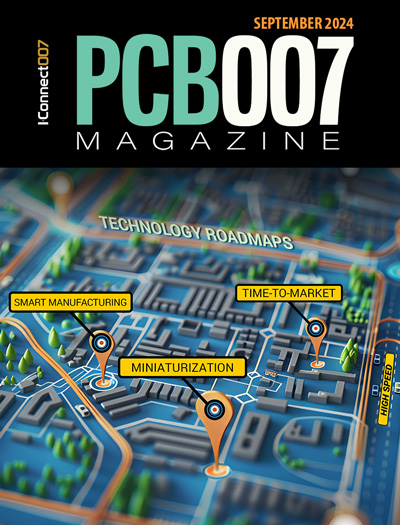-

- News
- Books
Featured Books
- pcb007 Magazine
Latest Issues
Current Issue
Engineering Economics
The real cost to manufacture a PCB encompasses everything that goes into making the product: the materials and other value-added supplies, machine and personnel costs, and most importantly, your quality. A hard look at real costs seems wholly appropriate.

Alternate Metallization Processes
Traditional electroless copper and electroless copper immersion gold have been primary PCB plating methods for decades. But alternative plating metals and processes have been introduced over the past few years as miniaturization and advanced packaging continue to develop.

Technology Roadmaps
In this issue of PCB007 Magazine, we discuss technology roadmaps and what they mean for our businesses, providing context to the all-important question: What is my company’s technology roadmap?
- Articles
- Columns
Search Console
- Links
- Media kit
||| MENU - pcb007 Magazine
Research on Bismuth Ferrite Could Lead to New Types of Electrical Devices
March 16, 2018 | University of ArkansasEstimated reading time: 3 minutes
Electrical devices in use today use conductive materials to guide electrons where they are needed. These materials must be fastened in place and insulated in order to keep the electricity on the right path. New research from the University of Arkansas makes a significant step toward a new kind of electrical device, which would use the natural properties of materials like bismuth ferrite, along with a different type of current, to send electricity quickly through smaller, denser circuits.
Image caption: The red lines in these images illustrate the domain walls separating regions of electric polarization (top) and shifting of charged ions (bottom row) in a material called bismuth ferrite. Researchers have demonstrated that these domain walls can be used to transmit a type of electrical current, which could lead to novel electrical devices.
Sergey Prosandeev, a research professor in the Department of Physics, worked with Yurong Yang, research associate professor; Charles Paillard, post doctoral fellow; and Laurent Bellaiche, Distinguished Professor. Their results are published in the journal npj Computational Materials.
Using the Arkansas High Performance Computing Center, these researchers created simulations of bismuth ferrite, a synthetic, crystalline material. Bismuth ferrite is “multiferroic,” which means that it has regions, or domains, in which the molecules making up its crystalline structure exhibit a consistent pattern of electric polarization, magnetization and shifting of charged ions. The boundaries between these regions are called domain walls. These walls are two-dimensional and very narrow—they are measured in tenths of nanometers.
In the simulation, the researchers created a type of current, called displacement current, by applying a high frequency electric field to the bismuth ferrite. Unlike the electric current that is produced by the movement of electrons, displacement current results from the vibration of ions in response to an electric field. The researchers found that the displacement current, which is an alternating current, or AC, naturally moves along the domain walls in the bismuth ferrite, and they also found that it is comparable in magnitude to the direct current, or DC, currently used in electrical devices.
Researchers can create domains and move domain walls in multiferroic materials by selectively applying electric fields. By demonstrating that these walls can be used to transmit displacement current, this research is a significant step toward new types of electrical devices.
The researchers explained that the compact nature of these devices would allow them to be very fast and very small. “This opens the way toward the design of fast nanoscale electronic circuits,” they said in the paper.
This research was sponsored by the Office of Naval Research and DARPA, the Defense Advanced Research Projects Agency.
About the J. William Fulbright College of Arts and Sciences
Fulbright College is the largest and most academically diverse unit on campus with 19 departments and more than 30 academic programs and research centers. The college provides the core curriculum for all University of Arkansas students and is named for J. William Fulbright, former university president and longtime U.S. senator.
About the University of Arkansas
The University of Arkansas provides an internationally competitive education for undergraduate and graduate students in more than 200 academic programs. The university contributes new knowledge, economic development, basic and applied research, and creative activity while also providing service to academic and professional disciplines. The Carnegie Foundation classifies the University of Arkansas among only 2 percent of universities in America that have the highest level of research activity. U.S. News & World Report ranks the University of Arkansas among its top American public research universities. Founded in 1871, the University of Arkansas comprises 10 colleges and schools and maintains a low student-to-faculty ratio that promotes personal attention and close mentoring.
Suggested Items
iNEMI HDI Socket Warpage Prediction and Characterization Webinar
11/15/2024 | iNEMIHigh-density interconnect (HDI) sockets, primarily designed for CPUs and GPUs, are shifting toward larger form factors as the number of interconnect pins increases.
Siemens Strengthens Leadership in Industrial Software and AI with Acquisition of Altair Engineering
10/31/2024 | SiemensSiemens has signed an agreement to acquire Altair Engineering Inc., a leading provider of software in the industrial simulation and analysis market.
Duality AI Contracts with NASA JPL for Phase II of DARPA RACER Program
09/13/2024 | BUSINESS WIREDuality AI, the company behind Falcon, a digital twin simulation platform, today announced an agreement with NASA’s Jet Propulsion Laboratory (NASA JPL) in Pasadena to continue its work on Defense Advanced Research Projects Agency’s (DARPA’s) Robotic Autonomy in Complex Environments with Resiliency program (RACER).
Electronic Design Automation Market Valuation is Poised to Reach $35.3 Billion By 2032
08/08/2024 | Globe NewswireThe global electronic design automation market is projected to hit the market valuation of US$35.3 billion by 2032 from $15.8 billion in 2023 and at a CAGR of 9.75% during the forecast period 2024–2032.
CACI Awarded $319 Million Task Order to Provide Intelligence Systems Expertise to the U.S. Army
08/05/2024 | CAC, Inc.CACI International Inc announced that it has been awarded a five-year task order valued at up to $319 million to provide intelligence systems expertise to the U.S. Army, Communications-Electronics Command (CECOM), Software Engineering Center (SEC), Electronic Warfare and Sensors Directorate (IEWSD), Army Reprogramming Analysis Team-Program Office (ARAT-PO).


